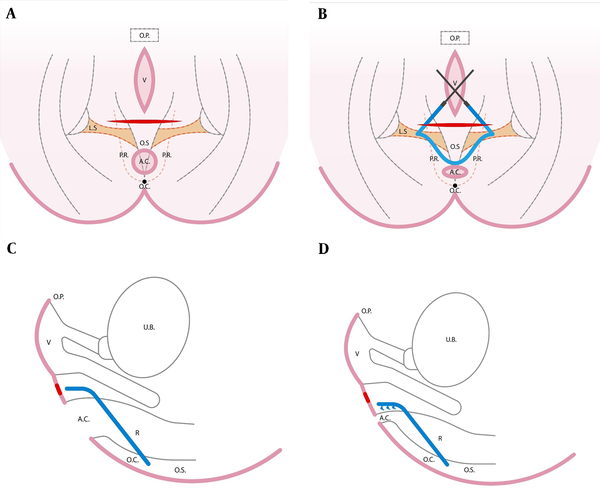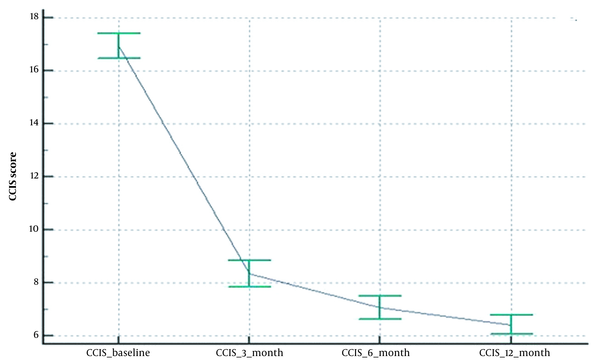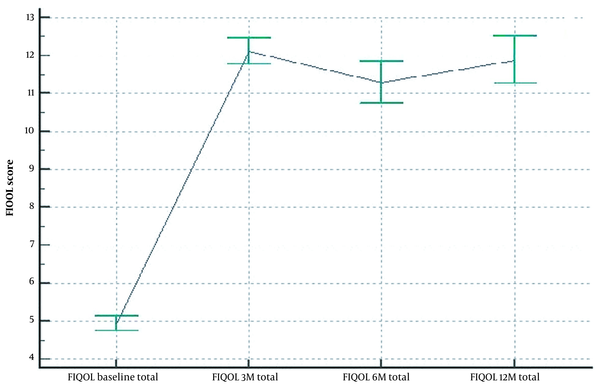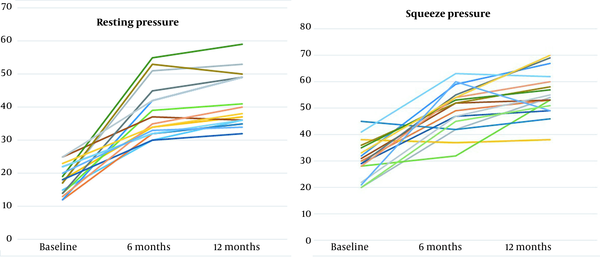1. Background
Fecal incontinence (FI) can negatively affect patients’ quality of life (QoL) and may lead to social isolation in adults (1). The pathophysiology of FI is multifactorial and includes bowel disturbance (particularly diarrhea), decreased rectal compliance (due to chronic diseases such as ulcerative and radiation proctitis), and damage to the anal sphincter (as a result of traumatic delivery or surgery) (2, 3).
Fecal incontinence treatment strategies include conservative management (behavioral and dietary modifications), physical therapies (pelvic floor muscle physical stimulation, biofeedback, bulking agents, and sacral nerve modulation (SNM)), and surgery (anal sphincteroplasty, artificial or magnetic sphincters, anal sling, and colostomy) (4). Moreover, a well-placed stoma created by colostomy can be successful in most cases but requires psychosocial commitment due to the anatomic and functional alteration of becoming a permanent ostomate (5). Therefore, introducing an effective strategy can assist in overcoming the current challenges of FI treatment.
Surgical interventions used to manage pelvic floor abnormalities in FI include anterior levatoroplasty, postanal pelvic floor repair, and total pelvic floor repair (6). Our team designed the ventral pelvio-anal reconstruction (VPAR) as a modified surgical technique for pelvic floor reconstruction. This technique is based on generating anterior support for the anal canal and restoring the strength of the forward action of the puborectalis muscle. Similar to the pelvic mesh used in stress urinary incontinence (7), we used mesh on a different anatomic site to create the pelvio-anal support. We assumed this technique might be an effective pelvic floor repair approach in patients with FI.
2. Objectives
In the present study, we experimentally used VPAR on patients with severe and refractory FI and reported its efficacy and safety during mid-term follow-up in the current manuscript. Confirmation of the effectiveness and safety of this procedure can be a great accomplishment in treating patients with severe and refractory FI.
3. Methods
3.1. Setting and Data Collection
This study included 17 consecutive adult patients (age ≥ 18 years) with refractory FI (unsuccessful treatment history) who were presented to the KEM Evang Clinic Essen-Mitte gGmbh, Henricistrasse, Essen, Germany, and Krankenhaus Maria-Hilf Hospital, Diesemer Bruch, Krefeld, Germany between June 2018 and June 2020. Patients with current colorectal or elsewhere malignancies, inflammatory bowel disease, rectocele, and pelvic septic disease were excluded. Following a detailed medical history and a thorough proctologic anorectoscopy and colonoscopy examination, as well as endoanal sonography, patients’ demographics (age, sex, and race), type of delivery (women), etiology of FI, previous treatments received, length of hospital stay (LOS), minor and major complications, and the results of follow-up examination were recorded. At each visit, including baseline (before surgery) and each follow-up visit, a physician interviewed the patients and completed the Cleveland Clinic Incontinence Score (CCIS) and Fecal Incontinence Quality of Life (FIQoL) questionnaires. Manometry was performed at the baseline (before surgery) and each follow-up visit.
3.2. Operative Technique
This study was performed in line with the principles of the Declaration of Helsinki. Since patient treatment was not affected by the retrospective study, it was covered by the ethical approval of the local ethics committee, and therefore, no individual ethical approval was necessary. Before the operations, the procedure was performed on cadaveric specimens to evaluate the technique and prevent potential complications during the real-life surgery. Colon preparation was done for all patients. Surgery was performed under general anesthesia in the lithotomy position. Intravenous antibiotics (including metronidazole and cephalosporins) were administered simultaneously with anesthesia induction. The perineal skin area was prepped with betadine scrub as performed elsewhere. Access to the sacrospinal ligaments was created via a transverse incision on the perineum (Figure 1A) and mobilization of the perineum body up to 4 cm. A lateral blunt dissection was performed to enter the ischio-anal fossa and reach the depth of the sacrospinal ligaments. After palpation of the middle part of the sacrospinal ligament, a mono-acryl suture was passed through the ligament and, using the i-Stitch® suture fixation device (Agency for Medical Innovations GmbH, Feldkirch, Austria), was bilaterally attached to the arms of the 2cm wide u-shaped mesh (Figure 1B). Before the sutures were tied, the mesh was secured to the ventral anal canal at the superficial part of the external anal sphincter, up to the anorectal junction (Figure 1C). When the sutures were tied to the sacrospinal ligaments, the anterior side of the anal canal was compressed to free the posterior canal (Figure 1D). The incision was closed in layers in a conventional manner.
The mesh used in this procedure was the BSC® (bilateral sacrospinous colposuspension) mesh (Agency for Medical Innovations GmbH, Feldkirch, Austria), which is non-resorbable, polypropylene, and U-shaped. The upper arms of the U-shaped were fixated at the middle of the sacrospinous ligaments, and the middle part was fixated ventrally to the anal canal at the level of the anorectal junction as described elsewhere. The tip of the i-Stitch® was positioned behind the ligament before a hollow needle with the suture inside was pushed through the ligament. Subsequently, the needle was removed, with the sutures remaining penetrating the ligament.
All statistical analyses were performed using IBM SPSS Statistics for Windows, Version 25.0. (Released 2017. Armonk, NY: IBM Corp, USA). P-values < 0.05 were considered significant.
(A) The transverse perineal incision; the pelvic floor view in the lithotomy position. (B) After inserting the mesh, it was sutured to both sacrospinous ligaments anterior to the anorectal junction; pelvic floor view in the lithotomy position. (C) Longitudinal section of the pelvic floor showing the position of the mesh before tying the sutures to the sacrospinous ligaments. (D) Longitudinal section of the pelvic floor showing the position of the mesh after tying the sutures to the sacrospinous ligaments. Abbreviations: O.P., pubic bone; V, vagina; O.S., sacral bone; O.C., coccygeal bone; A.C., anal canal; L.S., sacrospinous ligaments; P.R., puborectalis muscle; U.B., urinary bladder; R, rectum.
4. Results
The majority of the 17 patients included were female (15/17). The median (IQR) of the patients’ age was 79 (57.5 - 82.5) years, all Caucasians. Most women had a vaginal delivery (N = 13; 2 to 4 times). The etiologies of FI were: idiopathic (65%, N = 11), anorectal surgery (18%, N = 3), and neuropathic (12%, N = 2); only one patient had a congenital anomaly.
Most patients (N = 13) had undergone either peripheral nerve evaluation (59%, N = 10) or SNM (18%, N = 3), and the remaining four patients had low compliance for these two investigations, and had artificial bowel sphincter (ABS; 12%, N = 2), dynamic graciloplasty (12%, N = 2), and magnetic sphincter augmentation (MSA; FENIX®, 12%, N = 2).
The Median LOS was 4 (range: 3 - 5) days, and none of the patients had major complications. The only minor complication occurred in one patient who developed swelling and erythema of the perineal wound three days after surgery. She received antibiotics and antipyretics, and no implant had to be removed.
The median follow-up time was 12 months (12 - 15 months). At the last follow-up session, the surgeon reported that the operation was successful in all patients. None of the patients reported any functional complications, such as obstructed defecation or dyspareunia. There were no erosions, extrusions, migrations, or complications attributable to the mesh.
In all patients, the results of repeated measures ANOVA for trends of changes in CCIS and FIQoL showed a statistically significant difference between the time points (F = 254.08, P < 0.001 and F = 88.66, P < 0.001, respectively) (Figures 2 and 3).
The median resting pressure before the surgery was 18 (range: 12 - 25) mm Hg, which nearly doubled six months after the operation and reached a median of 35 (range: 30 - 55) mm Hg. This increasing trend continued until the last follow-up, with a median value of 38 (range; 32 - 59) mm Hg 12 months after surgery (Figure 4A). The median baseline squeeze pressure was 30 mmHg (range; 20 - 45), with 66% increase six months after surgery, reaching a median of 50 (range; 42 - 63) mm Hg. A stable trend was recorded until the final follow-up. We noted a median value of 54 mm Hg 12 months after surgery, with a minimum of 46 and a maximum of 70 mm Hg (Figure 4B).
5. Discussion
The present study introduced a novel combination of surgical procedures for patients with FI. Although several treatment options are available for FI, non-operative interventions can only alleviate the symptoms without addressing the underlying mechanisms. Surgery is generally the preferred intervention-especially in patients with severe FI- and includes a variety of procedures such as anal sphincter repair, sphincter replacement, SNM, and bulking agents, which are selected according to the pathophysiology of the disease (6, 8). A network meta-analysis on 37 treatment strategies proposed for patients with (severe) FI showed that SNM and zinc-aluminum had a positive impact on FI and FIQoL scores. Nevertheless, other studied treatment strategies did not alter FI frequency, resting, and squeeze pressures; some (such as radiofrequency) even resulted in more adverse outcomes than the placebo (9). Therefore, the question arises as to what would be the best decision if a patient has contra-indication for these interventions or does not comply with them or respond to them.
According to the guidelines, the SNM procedure, as the first-line treatment for all FI patients with or without sphincter defects (10), demonstrated encouraging long-term outcomes, even in patients with refractory FI (11). Improvement of an impaired sphincter function (targeting the sacral nerve root by implantation of the stimulating electrode) using the SNM procedure has led to encouraging long-term results in several cohort studies (12, 13). This method has also been validated as an effective procedure in patients with refractory disease and poor response to other treatment options (11). However, the management of patients who do not respond to SNM remains a significant challenge. In the present study, most patients had received either peripheral nerve evaluation or SNM with no response to either. The rest of the patients had low compliance with these treatments and thus underwent sphincter replacement surgeries such as ABS, dynamic graciloplasty, and MSA. A recent study showed that many patients who underwent ABS required re-operation (due to infection and device failure), and only 35% had achieved continence at the end of the cohort (five years) (11, 14). Notably, the management of patients with refractory conditions remains a challenge (15). The results of the present preliminary study showed that the combined procedure might be considered an effective therapeutic method with a significant impact on patients’ FIQoL, CCIS, and rest/squeeze pressures when SNM and other treatments fail to improve patients’ conditions.
Considering the fact that the injury to the anal sphincters is a frequent etiology of FI (as also observed in the present study), other surgical approaches have been proposed for the reconstruction of the pelvic floor integrity and stabilization of the perineal body and anal sphincters/canal. Nevertheless, these procedures (such as sphincteroplasty) have a high long-term relapse rate (16, 17). Considering the association of relapse with tension, some surgeons have proposed using Prolene mesh in sphincteroplasy as a novel tension-free technique (18). Total pelvic mesh repair (TPMR), which uses mesh to secure the perineal body to the sacrum, has also been recommended for patients with FI caused by pelvic floor prolapse (19). The transobturator post-anal sling (TOPAS) has also been utilized to modify the anorectal angle in FI patients by means of insertion of a mesh lateral to the puborectalis muscle and inferior to the anorectum. Besides the common complication of pain and incision site infection (> 5%), no mesh erosions, extrusions, organ perforations, bowel obstructions, or device revisions have been reported in this procedure (20). In addition, suturing the puborectalis sling between the anorectum and vagina to increase the anorectal angle has been proposed for reconstruction and reinforcement the pelvic floor; however, these procedures are not widely accepted because of the long-term adverse outcomes (21).
As we incorporated the implant into the perineal body, we anticipated that our technique would result in favorable outcomes, and the preliminary results were satisfactory. From an anatomical perspective, the perineal body is the focal point of attachment of pelvic muscles and fascia that are suspended to the sacrum by the uterosacral ligament. As explained in the TPMR procedure, the mesh can reconstitute the fascial attachments and reinforce the endopelvic fascia. The lateral sutures can also fix the rectocele (19). The BSC® mesh was used in the current procedure considering its high porosity, which facilitates ingrowth of the connective tissue and prevents adverse tissue reactions. Moreover, the U-shaped structure of the mesh allows a more secure fixation. Furthermore, i-Stitch® was used to assist in suturing and fixation of the mesh at the sacrospinous ligaments and minimize the incision while allowing efficient access to the sacrospinal ligaments. The use of mesh in pelvic floor operations is frequent in gynecological surgery, but recent guidelines consider it controversial because of the high risk of complications (7). In the present approach, unlike gynecological procedures (fixation of the mesh between the ventral wall of the rectum and dorsal wall of the vagina, which might lead to frequent complications), we inserted the mesh between the anterior anal sphincter muscle and the anterior part of perineum body or the delivery scar tissue and anchored the i- stich to the medial sacrospinal ligament. The mesh was fixed bilaterally to the sacrospinous ligaments to support the anterior aspect of the anal canal. If the puborectalis muscle is contracted (in the direction of the implanted mesh), this would compress the anal canal, resulting in a higher anal pressure than the rectum, thereby restoring continence.
Most available guidance on using mesh in colorectal surgery lack high-quality data derived from randomized clinical trials, contains significant heterogeneity in the indications, and failed to report complications (22). Nevertheless, except for one minor adverse outcome (local inflammation), we observed no complications in the present study. Aware of the controversy surrounding using mesh in pelvic floor surgery, we performed VPAR in patientsat in the final stages of the management (although none had undergone colostomy). Therefore, long-term follow-up is needed to confirm the safety and efficacy of this surgical intervention.
Some notable limitations of the present study were the small number of participants who were not randomly selected, their inclusion only from one medical center, the lack of a control group for comparing the results, and the short duration of follow-up. However, these limitations stem from the fact that what we report is the primary outcomes of a combination of previously-established surgical techniques.
5.1. Conclusions
The findings of his study suggest that ventral pelvio-anal reconstruction (VPAR) can be an effective and safe procedure for treating patients with severe and refractory fecal FI. Our modified, simple, and minimally invasive technique can support the anterior wall of the anal canal, leaving the posterior canal free with intact sphincter and puborectalis action. More studies are required for definite conclusions in this regard.



